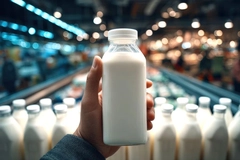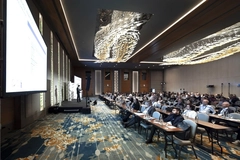Food Packaging in the US: Full Nutrition without Cooking

Americans have a hectic and mobile lifestyle. Many are no longer willing to waste precious time on food preparation and consumption.
19/10/05 It all really started about 50 years ago, when the first TV dinners were launched on the US market. The deep-frozen meals in the handy aluminium portion trays were not only heated quickly but also made the tiresome wash-up redundant. Convenience food was born. Today, half a century on, people have a hectic and mobile lifestyle. Many are no longer willing to waste precious time on food preparation and consumption. In the USA, few families gather for a meal nowadays. People eat in a hurry, on their way to work, at school, during a break, a quick snack in between, just before moving on to the next item on the day’s agenda. And this is true for everyone: adults, workers, mothers, adolescents, even babies are always on the go.
Simultaneously, people have become more health-conscious. In the ubiquitous American struggle against obesity, fatty foods have increasingly lost popularity. Those who try to eat healthily avoid the generally highly popular fast food restaurants, looking for healthy foods labelled ‘fat-free’ and more recently, and ‘low-carb’, in supermarkets. Food manufacturers have adapted to this trend, offering more and more products, snacks and packed lunches that act as substitutes for meals, are designed for consumption on the go and satisfy dietary requirements.
This ‘to-go’ trend is characterised by smaller units and multi-component snacks. To ensure that consumers do not have to struggle with bulky boxes and bags, most crisps and biscuits come in small, handy bags or tubs. They fit easily into a rucksack or lunchbox and contain a quantity just sufficient for one meal. In the car, the bags generally prove to be less handy. They fall over and the crumbly contents spill onto the seat and floor. It is here that the idea of offering biscuits in tubs has its merits. The base of the white, 12 cm high thermoformed polypropylene tubs is shaped such that it neatly fits into the mug holder. The opening, which widens to eight centimetres towards the top, is designed to allow an adult’s hand to reach into the tub with ease to retrieve the product. The containers are sealed safely and tamper-evident, with a metallized foil with humidity barrier. If the consumer does not wish to eat the entire portion at a time, the tub, which is sufficiently sturdy to be suitable for transport in bags and rucksacks, can be closed again with the blue, four-colour printed, thermoformed spring catch lid. Well-designed shrink labels ensure an overall attractive presentation.
More discerning consumers will find more upmarket snacks and packed lunches appealing, where various foods have been combined to produce a tasty meal. The challenge to the packaging manufacturer is to make meal components, prepared from the most varied ingredients, available to the consumer without compromising safety, freshness or the handiness of the format. Again, the keyword is convenience. The foods are prepared and designed such that they can be consumed on the go, without heating, where a microwave oven is not usually available. In the case of a fresh salad meal, this means an appreciable amount of packaging. The transparent thermoformed bowls not only keep the salad fresh, they also function as a salad bowl. The enclosed dressings are packed in plastic pouches or small tubs with sealing foils. A separately packed plastic fork and paper napkin complement the packed meal. For more complex salad mixes this can go as far as having an additional portion tray suspended in the upper part of a transparent bowl, where ham, croutons, cheese and dressings are neatly separated from each other in individual depressions. The entire package is sealed by clear film and carries a paper label with all the necessary product information.
In principle, portion trays are used wherever snacks are composed of various elements. They are generally deep drawn and, depending on the sensitivity of the food and its required shelf life, are made from polypropylene, polyester or polystyrene. The flat containers separate dry components, such as corn chips or crackers, from other ingredients like ham, cheese or jam, peanut butter or dips. Ham or cheese can be sealed in separate clear film, while liquid elements and dressings are sometimes presented in plastic pouches, but more commonly in plastic tubs sealed with aluminium foils or plastic films. Some packed lunches offer not only a dessert but also a beverage, either in a metal can or a pouch. In this case the beverage is next to the sealed portion tray. The units are combined in a folding cardboard box with a window.
Hardly any packed lunch still requires cooking or heating. Meals and snacks are designed such that they can be eaten directly from the packaging without any crockery or cutlery. The dairy industry adopted this idea some time ago. The small spoon to be joined together and offered in the lid of the yoghurt pot has been on the market for a few years. A relatively new idea is to modify such soft foods and their packaging such that they can be enjoyed without any cutlery. Today, Americans drink yoghurt from a plastic tongue or suck it from a plastic tube. A spoon is no longer necessary; indeed, it is no longer necessary to sit down at a table. In the car, on the school bus, in the schoolyard, the range of uses for the yoghurt tubes with their attractive print is unlimited. Because such packaging systems are used in particular to target young consumers, cutting-edge printing and decoration techniques play a relatively important role. Along with state-of-the-art packaging, such decorative processes will be presented in detail at interpack 2005, to be staged in Düsseldorf from 21 to 27 April.
Something still very novel to the dairy sector is the use of inks that glow in the dark. The pigments used for these inks absorb energy while exposed to normal light, which they then release in the dark. The image glows. An extra mention on the outer packaging and individual containers indicates that the inks are safe for use on food packaging.
The tubes are made of composite laminates consisting of low-density polyester/polyethylene and a sealant, or even of oriented polypropylene / ink / metallized oriented polyester and a sealant, co-extruded with ethylene vinyl alcohol, if they need to withstand peroxide treatment during sterile filling. It is also expected that these snacks will be stored in the freezer as a substitute for ice cream. The materials chosen allow for the packaging to be torn open easily and in a straight line along the groove designed for this purpose. The tubes are usually sleeves sealed on three sides, made and filled on vertical bag forming, filling and sealing machines.
The plastic tubes, generally with flexographic reverse printing, are obviously popular. Ever more products in the handy sleeve packaging are appearing in the shelves of American supermarkets. Even today, chocolate pudding, peanut butter and even apple purée for sucking are available. This is a trend that promises further interesting packaging solutions for the near future.











